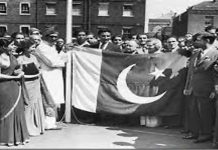
Everyone who has watched Pakistani news channels more than once must be familiar with the term “cracker attack” be they on shops, police personnel or people’s houses.
But what is this infamous cracker which sounds more like a toy devised by a rogue fireworks maker? Is it a dangerous form of a fire cracker or is, actually, a bomb?
It would turn out that every cracker is an IED (Improvised Explosive Device) but, every IED is not a cracker. “For the most part, it is a sphere packed with explosive material, a crude version of a hand grenade,” explained Sabir Khan, the chief of Karachi’s Bomb Disposal Squad.
The rule of thumb is that if a hand-hurled IED contains aluminum powder then it will fall under the broad definition of a cracker.
“A typical cracker, like the ones that are chucked at shops, is made of tennis ball. It is cut open and explosive material is stuffed inside. The material is usually aluminum powder and it explodes with a loud bang when a cracker is thrown at a hard surface. The aluminum powder is quite explosive and blows up at the slightest friction,” Khan explained.
Khan said an average cracker contains around 300 grams of explosive material. “On the other hand, a hand grenade has only 65 grams of explosive material but is considered more dangerous.” This is because a grenade is an ‘ordnance explosive device’ made in factories with specific combinations, he explained. “But the crackers are usually made by amateurs. They may contain more explosive material but might not always have the same destructive impact.”
However, that does not mean at all that the cracker bomb can’t be lethal. Since there is no standard formula, the composition of a cracker bomb can vary according to the purpose it is being used for.
“If you fill the cracker with shrapnel or nails, you have a pretty lethal bomb at your disposal,” said Khan. “Even if you stand at a distance, the speed shrapnel will fly and may cause serious injuries.”
An official of the Hyderabad Bomb Disposal Squad, Saleem Vistro, died in October, 2014 while defusing crackers found in an empty plot in Tando Allahyar. “His hand blew up when a cracker exploded in his hand and he died a day later due to excessive bleeding,” said the former Squad In-charge, Fakhrul Hasnain.
In 2014, on November 22, at least 23 workers of the MuttahidaQaumi Movement, including three members of the Sindh Assembly, were injured in a cracker blast targeted at a membership camp set up in Orangi town.
A week earlier, on November 15, a patrolling vehicle of Sir Syed Police Station narrowly escaped two simultaneous attacks in New Karachi, which fortunately did not explode.
Abid Farooq, head of Bomb Disposal Squad in the West Zone of Karachi, told News Lens Pakistan that each device weighing 650 grams was stuffed with nails. “They contained an extremely inflammable mixture of chemicals including aluminum powder and phosphorus, intending to explode immediately and set the vehicle ablaze.”
From popular use to generic scapegoat
Sabir Khan said the use of cracker bombs was initiated by extortionists to scare traders into paying them the amount of money they wished for.
Incidents such as that of lobbing a cracker at an oil shop in Qasba Colony, were pretty rampant a year or so ago. “But the use of crackers has now also spread to terrorists and other banned outfits and they use it when they want to create panic amongst people,” Khan said.
The Special Investigation Unit led by Senior Superintendent of Police Farooq Awan often seizes crackers, along with heavy ammunition while conducting raids on militant hideouts in Karachi.
SSP Awan told News Lens Pakistan that in July 2014, the unit arrested 33 criminals and recovered heavy ammunition including cracker bombs and Kalashnikov from different areas of Karachi.
Similarly, he said, on the eve of 9th Muharram in 2014, three successive blasts took place in Karachi. One of them was ‘crackers resembling tennis balls’ lobbed at a police picket in New Karachi resulting in injuries to two policemen.
However, the cracker is often confused by the local police with other forms of explosives, both intentionally and unintentionally, admitted a former official of the Crime Investigation Department, Inspector Haider Rizvi.
Rizvi conceded that the police or other security forces were in a habit of declaring explosions to have been caused by crackers when they wanted to downplay the extent of a certain event’s damage.
“When the police recover hand grenades in large quantities, they declare them as crackers because of the notion that crackers aren’t as dangerous,” Rizvi revealed.
Moreover, “Our policemen aren’t trained well, they cannot immediately differentiate between a grenade and a cracker blast,” Rizvi admitted.



